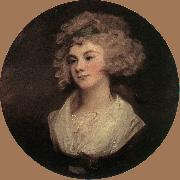
|
ROMNEY, George
|
|||
|
|
|||
| English Painter, 1734-1802 The son of a cabinetmaker, George Romney was born in Dalton, Lancashire. He was apprenticed in 1755 to Christopher Steele, a provincial portrait painter, but was largely self-taught. Romney's ambition was to become a history painter. In 1762 he moved to London, where he studied the Duke of Richmond's collection of casts of antique sculpture and established himself as a portraitist. He went to Italy in 1773, and after his return in 1775 he became the favorite painter of high society. Morbidly sensitive and retiring, Romney kept aloof from the social world of his sitters and from the Royal Academy. By 1782 he was under the spell of Emma Hart, later Lady Hamilton and the mistress of Nelson, who sat for him as Circe, a Bacchante, Cassandra, the Pythian Priestess, Joan of Arc, St. Cecilia, Mary Magdalene, and other impersonations he suggested. In the 1780s he executed a number of Eton leaving portraits, which established him as the supreme interpreter of aristocratic adolescence in his age. For much of his life in London, Romney was under the wing of the poet William Hayley, who encouraged him in the choice of subjects from Milton and Shakespeare as well as the Bible and Greek tragedy. Romney's history paintings are today chiefly known from engravings, like the dramatic Tempest (1787-1790) commissioned for John Boydell's Shakespeare Gallery. A large number of drawings for these projects survive. Romney had married early in life an uneducated woman whom he did not bring to London but to whom he returned when his health finally gave way. Ill health and the facility with which he converted his early realistic style into a fashionable sketchlike formula for idealizing his sitters probably account for an unevenness of execution that has partially justified his critics. Unlike Joshua Reynolds, Romney did not enter into the character of his sitters, unless they possessed nervous traits like his own, for example, the moving portrait William Cowper. But he was psychologically involved with the generalized charms of youth, beauty, and breeding that he admired in his aristocratic sitters, and by combining a neoclassic purity of line with free but masterly brushwork he achieved a number of incomparable images which transcend the realism of portraiture. | |||
|
|
|||
|
Lady in a Brown Robe s new1/ROMNEY, George2.jpg Painting ID:: 8954 |
c. 1785 Oil on canvas, 65 x 65 cm Tate Gallery, London | ||
|
|
|||
|
Also Buy::. For Following Paintings / Artists / Products, Please Use Our Search Online: |








